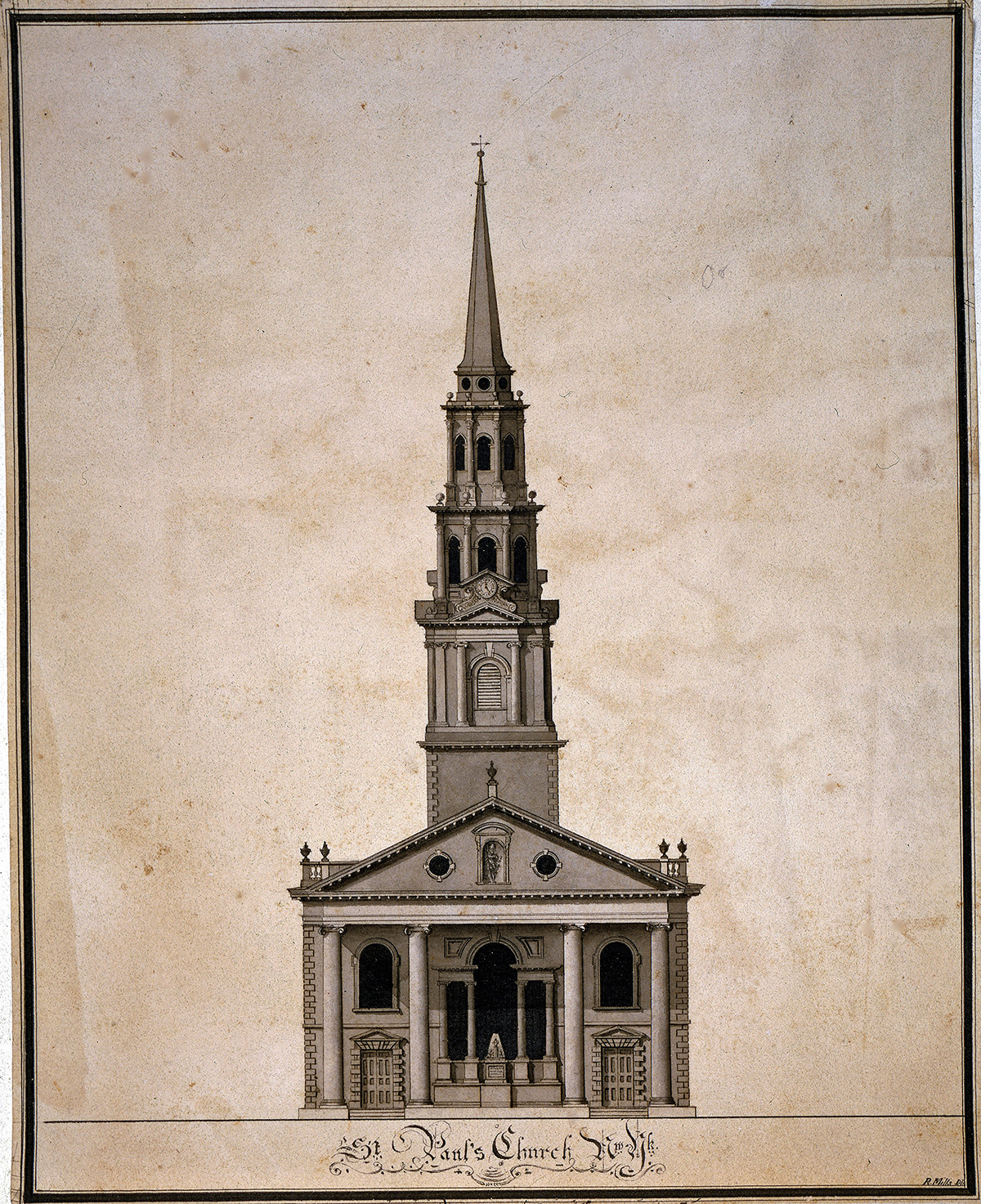St. Paul's Church (Drawing)
Artist/Maker: Robert Mills (1781-1855)
Created: c. 1802
Origin/Purchase: Washington, D.C.
Materials: ink and wash on paper
Dimensions: 23.2 × 18.9 (9 1/8 × 7 7/16 in.)
Provenance: Thomas Jefferson; by descent to Virginia and Nicholas Trist; by descent to a private collection; by gift to Thomas Jefferson Foundation in 1956
Accession Number: 1956-29
Historical Notes: Mills probably made his drawing of Thomas McBean's St. Paul's Church (1764-66) in lower Manhattan on his 1802-03 trip through the northern states to study architecture. The design was much influenced by the London church St. Martin-in-the-Fields (1722-26), designed by McBean's teacher James Gibbs.[1] Mills probably gave the drawing to Jefferson when he returned to Washington in 1803.[2]
The most important advancement of Mills's career came in 1803, when Jefferson introduced him to the British émigré architect Benjamin Henry Latrobe – whom he had just appointed surveyor of public buildings in Washington. Mills later told Jefferson that when he began working with Latrobe, "I began first to imbibe the true & correct principles of Architecture ...."[3]
My present ideas of this noble art & science, which are dramatically opposite to those I enter’d Mr. L[atrobe]’s office with, I trust are founded on the details of Reason & nature, because these are the only true foundations of correct taste, and real beauty.[4]
Mills worked under Latrobe for five years as a draftsman and clerk. When Mills entered his office, Latrobe's Bank of Pennsylvania, completed about two years earlier (1801), was commanding enormous attention.
When Mills decided to leave Latrobe's office in 1808 to establish a practice in Philadelphia, he wrote a characteristically complimentary letter to Jefferson. In seeking his help, Mills appealed to the president's well-known belief in the ability of the citizens of his country:
My wish is to endeavor to shew to the European who visits us from the metropolis of his country, that the american talent for architecture is not a whit inferior to the European's, under the same advantages.[5]
He also reminded Jefferson of his own "anticipations" on the future of American architecture as described in Notes on the State of Virginia:
perhaps a spark may fall on some young subjects of natural taste, kindle up their genius, & produce a reformation in this elegant & useful art.[6]
Mills believed himself to be one of the "young subjects" of which Jefferson spoke. His architecture helped set in motion the Greek Revival that Jefferson and Latrobe so vigorously championed.[7]
-Text from Stein, Worlds, 156
Further Sources
- Bryan, John Morrill. Robert Mills: America's First Architect. New York: Princeton Architectural Press, 2001.
- Bryan, John Morill, ed. Robert Mills, Architect. Washington, D.C.: American Institute of Architects Press, 1989.
References
- ^ Donald M. Reynolds, The Architecture of New York City (New York: Macmillan Publishing Co., 1984), 32-35.
- ^ John M. Bryan, "Robert Mills: Education and Early Drawings," in Robert Mills, Architect, ed. John M. Bryan (Washington, D.C.: American Institute of Architects Press, 1989), 3-4, 15.
- ^ Mills to Jefferson, October 3, 1806, Thomas Jefferson Papers, Library of Congress. Recipient's copy available online. Transcription available at Founders Online.
- ^ Ibid.
- ^ Mills to Jefferson, June 13, 1808, Thomas Jefferson Papers, Library of Congress. Recipient's copy available online. Transcription available at Founders Online.
- ^ Notes, ed. Peden, 153.
- ^ For an overview of Mills's career, see Bryan, ed., Robert Mills, Architect.
